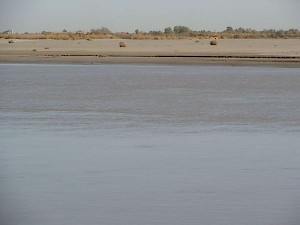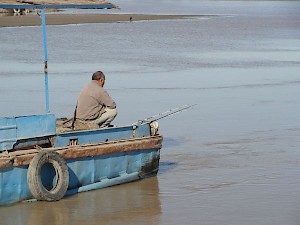Oxus (Amudar'ya)
Q8493Oxus: Greek name of a river in Central-Asia, now known as Amudar'ya.

Although its real ancient name, Waxš, means "the wild one", which suggests that it was not navigable, the river Amudar'ya can be used by ships for at least 1460 km, of a total length of more than 2400 km. Rafts may be used over an even greater distance. So, a very substantial part of it is not so wild that it becomes impossible for use by ships.
The sources of this stream are on the western slopes of the Pamir mountain range, where the ancient Silk road crossed into China.

The Upper Oxus flows from the east to the west through Bactria: Afghanistan on the southern bank, modern Tajikistan and Uzbekistan Tajikistan on the northern bank. This is a very fertile area with towns like Termez, Kara Tepe, Fayaz Tepe, and Kampyr Tepe.
Beyond Bactria, the river turns to the northwest. It divides two deserts, the Kara Kum (the "black desert", to the southwest) and the Kizil Kum (the "red desert", to the northeast). To the southwest is Margiana, to the northeast is Sogdia. The waters were not used for irrigation, nor were there many palms along the river; unlike the Nile, Euphrates, or Tigris, the Oxus was something of an intrusion in a desert landscape.

The delta immediately south of Lake Aral used to be called Chorasmia. Here, the waters were heavily used to irrigate the land. It is possible that in Antiquity one of its branches continued to the Caspian Sea.note
Not far from its sources, Alexander the Great (or his friend Hephaestion, to be more precise) founded the city of Alexandria, which controlled the trade in lapis lazuli.